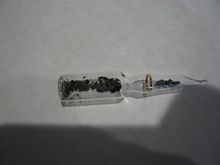Difference between revisions of "Arsenic"
m (Fixed some semantic info) |
|||
| Line 1: | Line 1: | ||
[[File:Arsenic1.jpg|thumb|220x220px]] | [[File:Arsenic1.jpg|thumb|220x220px]] | ||
| − | '''Arsenic''' is a metalloid with the symbol As and atomic number 33. It appears in pure form as a shiny, metal-like substance, though most samples are gray due to oxidation. Aside from its once-popular use in poisoning, arsenic was also used for wood treatment chemicals. | + | '''Arsenic''' is a metalloid with the symbol '''As''' and atomic number 33. It appears in pure form as a shiny, metal-like substance, though most samples are gray due to oxidation. Aside from its once-popular use in poisoning, arsenic was also used for wood treatment chemicals. |
==Properties== | ==Properties== | ||
| Line 15: | Line 15: | ||
==Availability== | ==Availability== | ||
Certain mineral ores of arsenic can be found at rock and gem fairs, such as skutterudite (CoAs<sub>3</sub>) and arsenopyrite (FeAsS). It can also be bought online. | Certain mineral ores of arsenic can be found at rock and gem fairs, such as skutterudite (CoAs<sub>3</sub>) and arsenopyrite (FeAsS). It can also be bought online. | ||
| + | |||
| + | In some places, the sell of arsenic and arsenic compounds is regulated. | ||
==Preparation/Isolation== | ==Preparation/Isolation== | ||
Revision as of 19:14, 11 August 2017
Arsenic is a metalloid with the symbol As and atomic number 33. It appears in pure form as a shiny, metal-like substance, though most samples are gray due to oxidation. Aside from its once-popular use in poisoning, arsenic was also used for wood treatment chemicals.
Contents
Properties
Chemical
Arsenic has two important oxidation states, +3 and +5. Notable compounds are arsine (AsH3), arsenic trichloride (AsCl3, "butter of arsenic"), and the two oxides As4O6 and As4O10.
Most of arsenic's compounds, as well as the element itself, are prone to sublimation at low temperatures (usually around 300 - 700 C).
Physical
Arsenic occurs in three major allotropes: grey(or metallic), black, and yellow. Grey is by far the most commonly encountered form, and has semimetal properties. The yellow allotrope is encountered as a yellow amorphous solid, produced by very rapidly cooling arsenic vapor, and is not to be confused with orpiment, the sulfide mineral of arsenic. Yellow arsenic will slowly convert to grey over time. Black arsenic is brittle, glassy, and crystalline, forming from the cooling of arsenic vapor to more moderately high temperatures in the range of 100-200°C.
Arsenic is unique among elements in that it typically does not occur in a liquid phase, but rather freely transfers between the solid and gas phases, often vaporizing even below its sublimation point, which only adds to the danger of this element.
Availability
Certain mineral ores of arsenic can be found at rock and gem fairs, such as skutterudite (CoAs3) and arsenopyrite (FeAsS). It can also be bought online.
In some places, the sell of arsenic and arsenic compounds is regulated.
Preparation/Isolation
If you do not have any experience handling arsenic compounds, it is highly recommended you do not try to produce arsenic. Do not produce arsenic indoors without excellent ventilation. A glove box is also ideal.
Assuming that one has thoroughly researched the toxicity of arsenic and proper handling procedures from a reliable source, there are two major ways to prepare elemental arsenic. The first the wet method - involving dissolving the cation part of the ore (usually some metal) in nitric acid, leaving behind a residue of arsenic(III) oxide and reducing this to the metal.
The second, and by far the most lethal, is to sublimate the crushed ore in a closed tube. It is absolutely required to weld the ends of the tube shut to prevent vapor of arsenic or arsenic oxides from escaping, and one should probably add some reducing agent such as carbon as well to prevent the arsenic vapor reacting with the air in the closed container. When sublimating, heating should be done so that all of the vapor collects at one spot - this will make collection of the sublimated product significantly easier.
Projects
- Extracting arsenic from skutterudite
- Element collecting
- Arsenic trioxide seynthesis
- Arsenic trichloride synthesis
- Organoarsenic compounds
Handling
Safety
Arsenic is notoriously one of the most toxic elements on the periodic table, as less than half a gram will cause death in a very painful fashion. When working with this, gloves, a lab coat, full facial protection, and a fume hood are a must. If volatilized and organic arsenic compounds are used, a glove box or gas mask is not optional - you must use one if you plan to live afterwards.
Toxicity of arsenic-bearing ores
The only arsenic ore that can be considered almost non-toxic (safe enough to handle by hand in powdered form) is skutterudite, due to its crystal structure effectively trapping the arsenic atoms in a lattice of cobalt, iron and sometimes nickel. Other ores such as arsenopyrite, realgar and orpiment are safe to handle by hand in bulk form, but not under any other conditions (and it's frankly recommended to not handle any of these by hand anyway).
Storage
Arsenic should be stored in closed bottles or ampoules.
Disposal
NEVER DUMP ARSENIC IN THE ENVIRONMENT! All arsenic compounds must be taken to hazardous chemicals disposal centers.
The only exception would be to redeposit it in the geological area from where you collected the arsenic containing mineral, as there is already arsenic in that area. Even so, the arsenic must be converted to an inert compound, to prevent it from infiltrating the groundwater.
